17th July 2007 - The wildflowers of Culloden moor
We went to Scotland last week Ė not a holiday but a weird work trip done to help out the company that a friend works for. She works for a cartographers and they needed some urgent maps to be made in Scotland of the car parks and surrounding areas of a certain supermarket that I shanít name here.
"We ended up in Elgin, along the coast from Inverness, and decided to have a bit of extra time to look about"
They have to get someone to go and actually make the maps on site, partly for copyright reasons and also because existing maps arenít always correct. Weíd downloaded maps from the internet for guidance and discovered all about the latter; more than once we ended up driving round for about half an hour looking for roads that donít exist.
It went fairly smoothly, us driving from town to town with our clipboards, making sketches, turning up at the friendly B&B places, porridge for breakfast and all that. The weather was kind to us Ė in fact, the further north we drove the warmer and sunnier it became. At the finish we ended up in Elgin, along the coast from Inverness, by which time we were tired of looking at supermarkets, and decided we'd take a bit of extra time to look at something else.
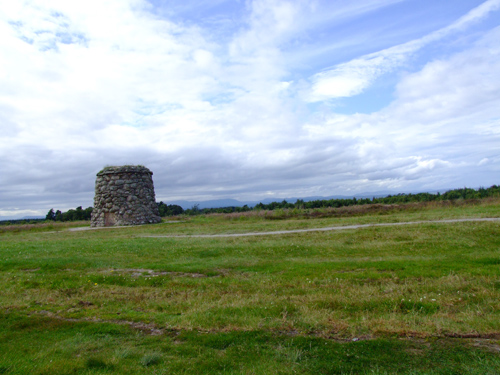
Culloden cairn
Iíd wanted to see Culloden battle ground for a good while so we set off towards Inverness to find it and see what was there. The battle of Culloden was fought in April 1746, the last on British soil, and I suppose some things must have changed in 261 years. The similarity is that the area where the fighting took place is still a rough and marshy moorland, probably not that different to how it would have been on that day. There isnít much to see, really, just a big open area of moor, laid with paths and with grave stones marking where the clans were buried, with mountains on one side and Loch Ness on the other. A few of the stones have flowers placed before them, some wild, others obviously brought here.
Itís a sad place with a weird atmosphere. Iíve been to battle grounds before (some the WW1 sites in France and Belgium) and remember the atmosphere there but they were different to this place, you almost feel as if youíre pushing through crowds of ghosts. Maybe that's part of what brings people here, just to get the feel of it, or maybe to see the graves of their ancestors. There seemed to be no shortage of visitors, that's for sure.
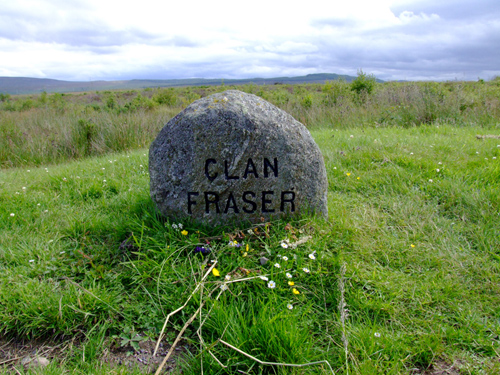
Clan Fraser grave stone
As we wandered about the pathways I tried to imagine how the moor might have looked that day, what might have been growing there. It seemed easier to think on that than the exhausted, hungry Highlanders who fought and died on that field. So I turned away from the graves and the burial mounds and started looking at the plants instead, to see life instead of death.
It was a pleasant surprise to see so many flowers. It shouldnít have been, there are bound to be flowers in a place that hasnít been farmed for so long, but a surprise it was and a welcome one. The place was full of life and colour with flowers nodding in the warm breeze and the buzz of bees and chirp of grasshoppers. I even saw a frog, though it didnít stay still long enough for the camera.
There the were plants you expect to see in Scotland, heather and thistles, rough grass, but amongst it all was a rich variety of wildflowers. As we walked along, my eye was caught by many patches of one of my favourite wild flowers, purple vetch (Vicia cracca). I love this plant with its masses of little purple flowers, the vividness of the colour is slightly unreal. This purple is one of the colours that really suits me, which makes it even better. It looked so pretty against the green of the grass and intense against the bright yellow of what may, or may not, have been horseshoe vetch (Hippocrepis comosa).
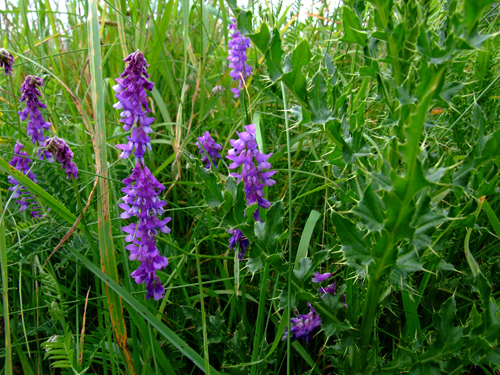
Purple vetch (Vicia cracca)
Next along the way I spotted white clover flowers (Trifolium repens) studding the grass, interspersed with purple flowering selfheal (Prunella vulgaris) and then something I hadnít seen before and had to look up when we got home. It was a yellow little pea-like flower, with fat seed pods, that turned out to be yellow rattle. Itís of the genus Rhinanthus, but whether it is the greater or lesser type I have no idea; they looked pretty similar to me in the book and, unless I feel an urge to use the leaves of R. minor for the yellow dye they produce, then I probably shanít bother to find out just at the moment.
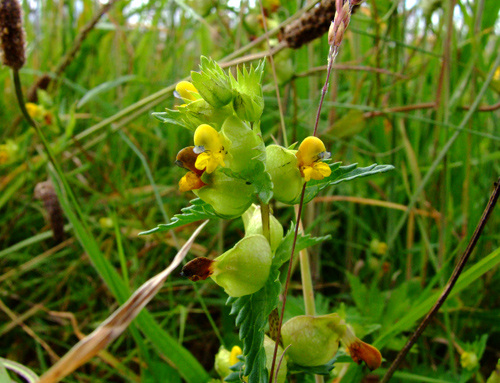
Yellow rattle (Rhinanthus)
A little further along and a patch of lurid pink appeared. Itís difficult to describe the shape of this flower, itís somewhere between a thin Aquilegia and pea. Anyway, the colours shade from bright ice-cream pink to a dark, almost black, magenta. It is known, rather strangely, as fingered fumitory (Corydalis consolida). Next to it, and clashing as well as any mixture of pinks can do, was some bistort (Polygonum persicaria), showing redder and even more sugary shades of pink than the fumitory. Those shades of pink really donít mix at all, not a bit, but in nature it never seems quite so out of place. The green of the grass and creamy yellow of nearby field pansies (Viola arvensis) toned things down a little, but just imagine what youíd think if you saw that combination in someoneís garden.
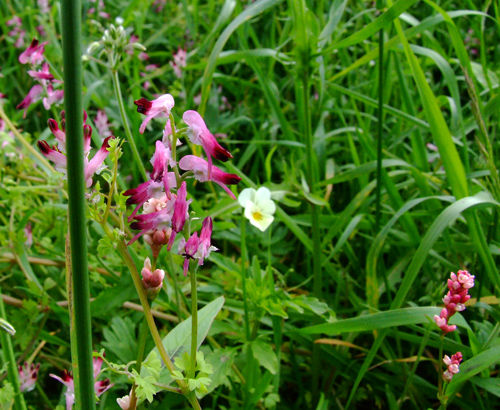
Fingered fumitory with bistort and field pansy
More subtle shades were seen in the form of scattered spotted heath orchids (Dactylorhiza maculata), their flowers looking like tiny white hankies embroidered with purple thread. However common an orchid may be, itís always exciting to see them growing in the wild. We also saw the rich dark pink common spotted orchids, which were beautiful alongside silver weed (Potentilla anserina), with its downy, silver sheen.
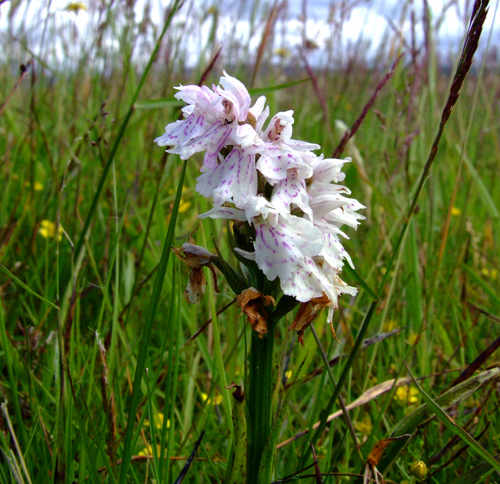
Spotted heath orchid
At the edge of the field we came across a large patch of I took to be a scentless May weed, though it seemed too big compared to the short stuff round here. There was bistort and the fingered fumitory growing here too, but not so close together. These big white daisy flowers never fail to make me smile and it was good to see them here.

May weed
Along the edges of the field a great deal of moss grows in the marshy peat and here I saw, for the first time, Chickweed Wintergreen (Trientalis europaea) growing with yellow flowered Tormentil (Potentilla erecta). Chickweed Wintergreen has pinky-white star-shaped flowers set above coppery leaves and the yellow stamens stand out proudly from the centre.
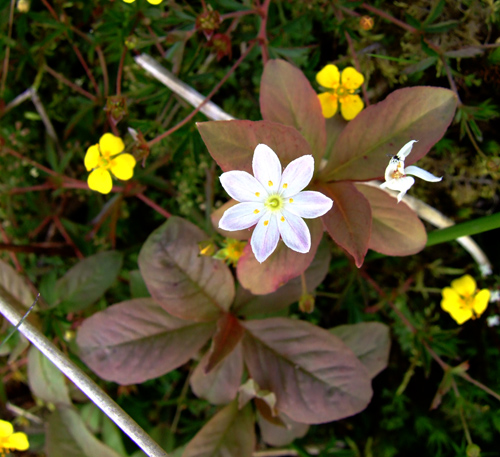
Chickweed Wintergreen
It was a bit of a strange visit, in all, wandering around thinking about fighting and flowers both together, but there was a sort of comfort in seeing so much growth and colour in a place where events had gone so badly wrong for one side. In the end it was the flowers that stayed with me.
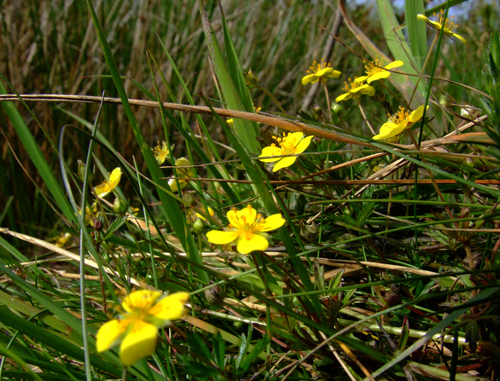
Tormentil
© Copyright Miranda Hodgson 2007